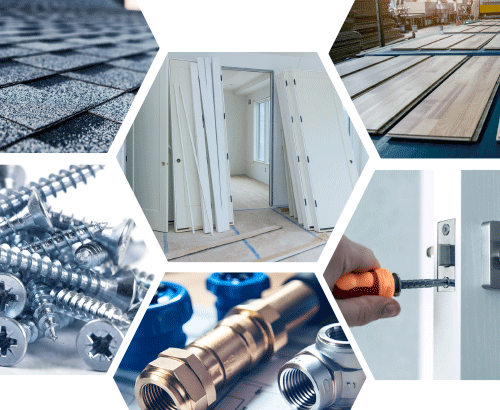Data Centers: Driving Innovation in Building Products

With all the talk about artificial intelligence, data analysis, digitization and other technological innovations that will shape our work in the future, it’s no surprise that demand is surging for buildings to store equipment to process all that information.
Spending on data centers is forecast to reach more than $30 billion by 2026, with an annual growth rate of more than 10% through 2026.
But it’s not enough to quickly assemble a metal building on a concrete slab and add servers. The design and construction of data centers are changing to incorporate increased demand and new trends in the industry, such as the need to be more energy-efficient.
In FMI’s recent Building Products Market Overview, we talk about how the decarbonization of buildings and demand for more cost-effective inputs will influence building products moving forward.
This is particularly true for data centers, which will be an increasingly large subsegment of office construction spending. Owners in high-growth niche areas of the industry, including data centers and life sciences, are focused on products to help improve speed to market, flexibility and adaptability in their buildings so they can meet fast-paced, evolving industry needs and building requirements.
Building products manufacturers and suppliers looking to capitalize on the money pouring into the sector will need to understand these new environmental, social and economic trends to adjust products and services to address shifting client demands. As more owners look for products to improve energy efficiency and cost-effectiveness, particularly as data centers grow and scale, building product providers will need to find ways to differentiate themselves from the competition.
Data centers have historically been constructed in a concentrated number of geographies such as Silicon Valley and Northern Virginia. However, secondary geographic markets such as Texas, Georgia and Arizona are seeing surges in demand. Remote and hybrid work models have played a role in influencing the need for data processing and connectivity outside of historical population centers and business districts.
As data center construction continues to expand in secondary geographies, understanding the nuances of local market factors driving owners’ decisions and how these facilities will evolve moving forward will be critical for building products companies to make strategic decisions around products and services.
Not One Size Fits All
The two most common types of data centers present different opportunities and challenges for building products manufacturers and suppliers.
- Hyperscale facilities house the servers and equipment for a specific technology company, such as Amazon, Google or Apple.
- Colocation facilities, or those frequently owned by developers, typically offer space for rent and are built by companies such as Digital Realty or CyrusOne. Often colocation data centers require customization of the layouts, products, offerings and other details since the space is configured to various companies’ specifications.
Hyperscale and colocation data centers represent more than two-thirds of the data center construction market. Following these facilities are edge data centers. Edge data centers are owned and operated by the company they support such as a bank or large retailer. These facilities are smaller and are often located near the operations they support.
Energy Is Driving Change
Energy efficiency is the biggest driver of data center design and construction. Data centers use an estimated 2% of the total electricity consumed in the U.S., and that is expected to grow. Since data centers consume 10 to 50 times the energy of commercial office buildings, product manufacturers that offer energy-efficient solutions have a distinct advantage over the competition.
This is especially true for hyperscale data centers since many large technology companies pledged to reduce their carbon emissions and integrate sustainability into their operations. Efficient containment solutions and airflow controls help mitigate energy usage and meet environmental targets.
These same solutions are also in demand for colocation centers since customers are increasingly demanding more sustainable and energy-efficient locations. Centers are also becoming denser, meaning they’re consuming more watts per square foot and emitting more heat. As the number of servers per location increases, the ability to control temperatures becomes more critical.
Products, such as hot aisle and cold aisle containment, that integrate doors and direct airflow to keep air temperatures separate help improve data centers’ energy efficiency and reduce temperature fluctuations. Building products manufacturers that offer solutions that can easily be reconfigured, moved or customized are gaining market share as data centers work to reduce their carbon footprints.
Furthermore, with the growing demand for new centers and processing capabilities, many owners are turning to prefabrication and modularization to reduce construction timelines. This allows them to more quickly open new locations where demand is needed. Products that are assembled off-site often include information technology racks, power and cooling systems, fire suppression and security systems. Raised floor systems, particularly those that can be quickly reconfigured, are also often prefabricated to make sure cutouts for cabling and power are placed accurately.
Product Trends
One of the biggest components for data centers is cooling systems. A variety of cooling systems and methods, such as chilled water systems, are utilized. Advanced cooling systems, such as liquid cooling (e.g., direct-to-chip, immersion), are being considered by more firms as they offer improved cooling efficiency and reduce energy consumption. Additionally, these systems help to improve the reliability of data centers, reducing the risk of equipment failure due to overheating.
One example of this is Meta’s restructuring of its data centers to prepare for high-performance computing and AI reliance. This restructuring is anticipated to accelerate Meta’s implementation of liquid cooling to support the AI-powered data center operations. Additionally, IBM and Schneider Electric are experimenting with self-contained, rear-door water cooling units.
Another popular technique is raised access flooring that is commonly used in data centers to provide space for cables and other infrastructure while allowing for easy access to equipment. The flooring system can also help distribute cool air evenly throughout the data center space, improving energy efficiency and reducing the risk of hot spots. Structural ceiling grids provide flexibility and improve layout design to drive further densification abilities and options. As the needs from owners and tenants change, these flexible floors and ceilings are easily reconfigured to meet new layouts and quickly adapt to shifting demands. Companies in this space have evolved their offerings to include various materials, finishes and load-bearing capacity options.
Aisle containment is another popular solution for data centers looking to improve energy efficiency, reduce cooling costs and optimize cooling performance. Aisle containment is particularly effective in high-density data center environments, where the use of hot-aisle and cold-aisle containment systems can help reduce energy consumption by improving cooling efficiency. The ability to customize a containment system based on specific needs of the facility (e.g., high-density facilities, facilities with varying rack densities) is highly valuable and enables these solutions to be utilized for new construction and retrofit projects.
Finally, another emerging trend includes advanced exterior building panels, such as insulated metal panels (IMPs). IMPs have been increasingly used in data center construction due to their superior thermal performance, durability and speed of installation. With expedited schedules in this market, products offering a shorter production schedule provide an increasingly attractive option.
Position Your Product for Success
It’s important to make sure that your products are evolving and adapting to market demands to gain share. Many data center owners are more concerned with availability and performance than price, giving many manufacturers the chance to win business by demonstrating their products’ capabilities. In high-demand markets, being able to quickly supply components to open data centers is a key way to beat the competition.
Other ways to differentiate your products include:
- Focus on quality and reliability. Data centers are critical facilities that require products and systems that are reliable, efficient and highquality. Downtime and product failures can result in significant financial losses for these businesses. Manufacturers that provide products to meet these standards will have a better chance of success.
- Offer customization and flexibility. Data centers have unique requirements, and manufacturersthat offer customized products and systems to meet those requirements will have an advantage. By working closely with data center professionals to understand their needs and offering customized solutions, manufacturers can differentiate themselves from competitors. It’s also important to be highly flexible, which allows data center operators the ability to customize systems to meet their specific needs. Operators are demanding the ability to reconfigure layouts of the raised floors, as needed, to accommodate changes in the layout or equipment.
- Provide comprehensive support. Data centers are complex facilities that are constantly evolving. Manufacturers with comprehensive support services, including design input, product recommendations and training, will be more likely to get their products specified by designers. By demonstrating a commitment to providing excellent customer support, manufacturers can establish themselves as trusted partners in the data center industry.
Understanding key market demands, product trends and geographic nuances in the data center industry will differentiate your building products from the competition. Companies that make a deliberate and dedicated effort to understand the market will be in the best position to determine product opportunities, gaps in the market and new ways to expand their businesses.



